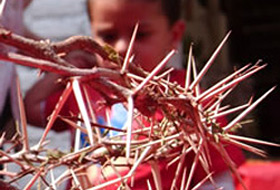 |
 |
 |
 Vallarta Living | April 2006 Vallarta Living | April 2006  
Indigenous Traditions Enrich Mexico´s Easter Celebrations
 El Universal El Universal


| | In the capital precinct of Iztapalapa, the crown of thorns that will be used in the annual reenactment of Christ’s crucifixion is on display. Every year, hundreds of thousands flock to Iztapalapa for the event (El Universal) |
The traditions and customs of Mexico´s scores of indigenous peoples have greatly enriched the Christian faith brought here by the Spanish, a phenomenon especially evident during Holy Week.

The result has been unique and picturesque interpretations of Holy Week traditions.

"The religious celebrations of Mexico´s indigenous communities incorporate the European heritage and give it a special syncretism," Fred Álvarez, a religious expert, told EFE.

Indigenous peoples constitute about 10 percent of Mexico´s population of just over 100 million.

The practices of the 62 indigenous ethnic groups recognized in Mexico "vary greatly from one to the other," Álvarez said, adding that "a separation of a few kilometers (between communities) can make them totally different."

The celebrations tend to have a common element in the traditional dances of each town, performed wearing ceremonial masks.

Other practices, such as those of the indigenous in the mountains of the western state of Nayarit, consist of a ritual in which civil authorities cede control over public life to a ceremonial group.

In the town of Santa Teresa, in Nayarit, the indigenous wear costumes during an eight-day celebration and portray characters from the time of Christ, such as pharisees, demons and even Jesus of Nazareth himself.

Rituals and processions are staged, both by day and at night, following a strict order, since it is believed that evil comes out during Holy Week and the "harmony of the cosmos" is threatened.

Townspeople stage battles among different ceremonial groups, culminating with the death of Christ, which they refer to as Hatzican, Holy Burial, Morning Star or Star of the Sun. With the final procession and the crucifixion, which the indigenous believe causes the "death of evil," power is returned to civilian authorities.

In addition to indigenous Catholic rituals, numerous types of religious celebrations are held by Catholics across Mexico.

The procession in Taxco, where many residents flagellate themselves as an act of penance for their sins is one example.

In San Luis Potosí, residents stage a silent procession on Good Friday in which local brotherhoods march carrying giant images of Christ´s last moments.

The most elaborate and popularly acclaimed dramatic representation of the Passion of Christ in Mexico is held in Iztapalapa, on the east side of Mexico City. | 
 | |
 |



